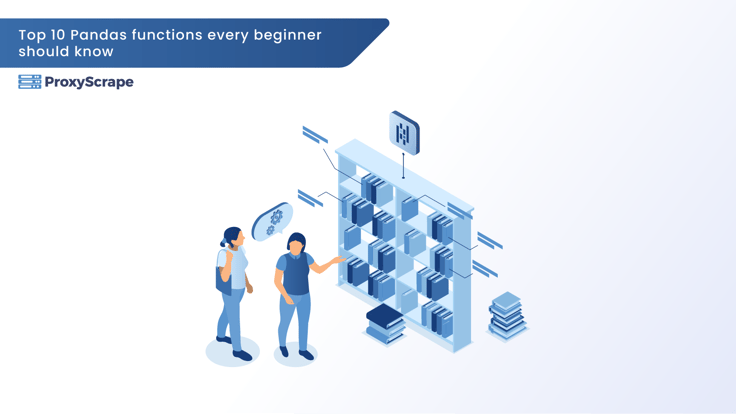Pandas is the go-to library for data analysts and Python programmers venturing into the world of data manipulation and analysis. Its intuitive syntax and powerful data structures make handling vast datasets not only manageable but also efficient. Whether you're importing CSV files, cleaning messy datasets, or analyzing data trends, Pandas has the tools you need.
Author: ProxyScrape
How to scrape tables from websites – a Python tutorial
By: ProxyScrapeDec-13-2024
Web scraping has become a vital skill for Python developers, data analysts, and anyone working with datasets. When it comes to structured and rich data, tables found on websites are often goldmines of information. Whether you’re scouring the web for product catalogs, sports statistics, or financial data, the ability to extract and save table data using Python is an invaluable tool.
This practical guide takes you step by step through the process of scraping tables from websites using Python. By the end, you’ll know how to use popular libraries like requests, Beautiful Soup, and even pandas to access table data and store it in reusable formats like CSV files.
How to Integrate Proxies with Postman: A Step-by-Step Guide
By: ProxyScrapeDec-05-2024
API testing and development are critical tasks for developers, IT professionals, and testers. Among the tools available, Postman stands out as a powerful and user-friendly platform for sending requests, analyzing responses, and debugging APIs.
How to Set Up Proxies in Selenium for Web Scraping
By: ProxyScrapeNov-27-2024
When working with Selenium for web scraping or automation, integrating proxies is a must. Proxies allow you to bypass bans, rate limits, and geo-restrictions, making your tasks seamless and efficient. But configuring proxies in Selenium can be a challenge, especially if you’re dealing with authentication or need to monitor HTTP requests. That’s where Selenium Wire comes in.
Website Performance Load Testing using JMeter and Proxy.
By: ProxyScrapeNov-21-2024
In the digital age, where every second counts, ensuring your website's performance is up to par is not just a necessity—it's a survival strategy. With users' expectations higher than ever, a slow-loading page could mean the difference between a converted customer and a lost opportunity. This is where Apache JMeter™ and proxy servers come into play, offering a powerful combination for load testing your website to ensure it can handle high traffic volumes without compromising on speed or user experience.
How to Scrape eBay in 2024: A Beginner's Guide
By: ProxyScrapeNov-21-2024
eBay is one of the world’s largest online marketplaces, hosting millions of products across various categories. Scraping eBay can be invaluable for tasks like:
- Price Comparison
- Market Analysis
- Tracking Product Trends
In this guide, we’ll show you how to create a simple Python script to search for a keyword, extract product details like title, price, currency, availability, reviews, and ratings, and save the data into a CSV file. This tutorial is great for beginners who want to learn web scraping the right way, with tips on respecting terms of service and using proxies responsibly.
Getting Started with Robots.txt and Sitemaps for Web Scraping
By: ProxyScrapeNov-13-2024
In the vast digital landscape, where countless websites compete for attention, it's crucial to understand the rules of engagement. For web developers, SEO professionals, and content creators, decoding robots.txt is key to ethical and effective web scraping. This guide will help you understand how to responsibly interact with websites using robots.txt and sitemaps.
A Guide to HTML Selectors for Web Scraping
By: ProxyScrapeNov-08-2024
HTML selectors are key to web scraping, allowing developers to target specific elements on a webpage. By using these selectors, developers can extract data precisely.
Web scraping involves getting data from websites by navigating their HTML structure. HTML selectors are crucial, letting you pinpoint specific tags, attributes, or content. Whether extracting product prices or headlines, selectors are your guide.
Using HTML selectors effectively streamlines data extraction and reduces errors. They help you focus on important elements, saving time and effort in gathering insights from online sources.
Web Scraping with Kotlin Programing Language
By: ProxyScrapeOct-26-2024
In today's data-driven world, information is power. Those who can efficiently gather and analyze data hold a distinct advantage. Web scraping has quickly become an essential tool for developers and data analysts looking to extract valuable information from websites. But why choose Kotlin for this task? Kotlin, a modern programming language, offers a fresh perspective and powerful tools for web scraping, making it simpler and more efficient.
Anti-Bot Systems: How Do They Work and Can They Be Bypassed?
By: ProxyScrapeOct-07-2024
Anti-bot systems are technologies designed to protect websites from automated interactions, such as spam or DDoS attacks. However, not all automated activities are harmful: for instance, bots are sometimes necessary for security testing, building search indexes, and collecting data from open sources. To perform such tasks without being blocked by anti-bot systems, you will need specialized tools.
